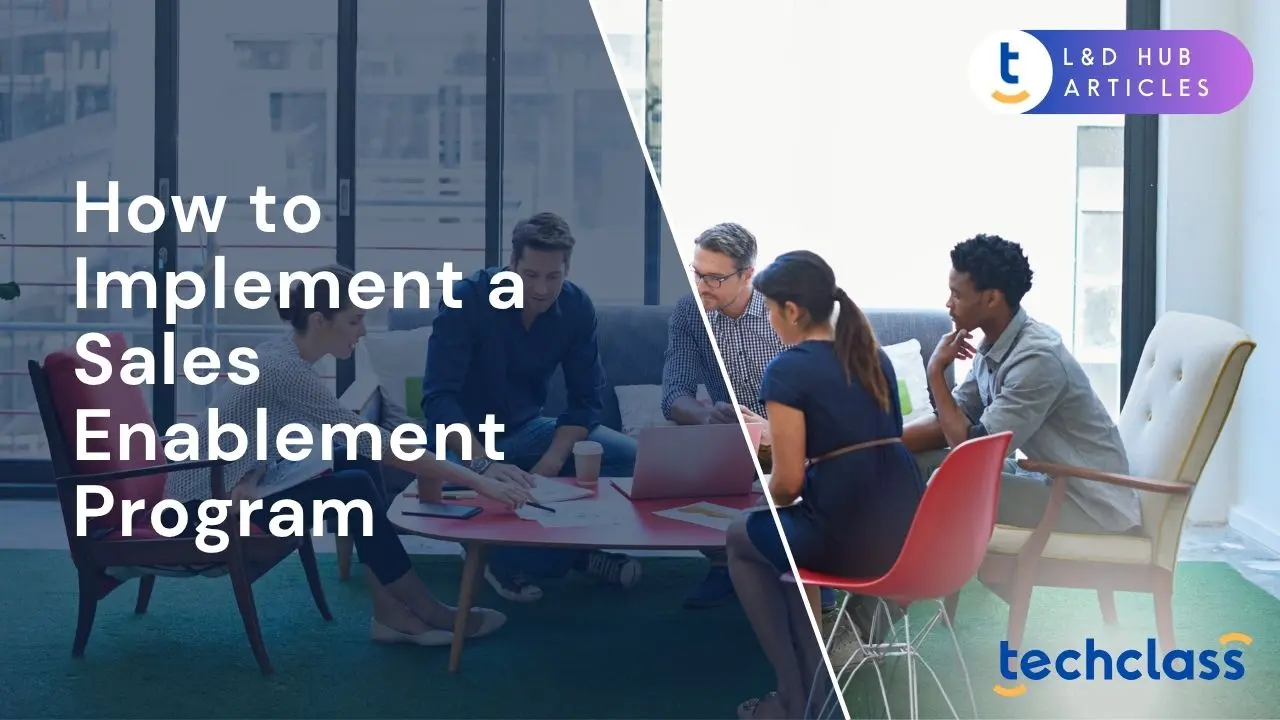
In today’s competitive business landscape, empowering your sales force with the right resources and training is no longer optional—it’s essential. Sales enablement is the practice of equipping sales teams with the content, knowledge, tools, and support they need to sell effectively. Its importance has skyrocketed in recent years: over 90% of businesses now have a dedicated sales enablement program or team, underscoring that companies without one risk falling behind. A well-implemented sales enablement program can bridge gaps between departments, improve sales productivity, and ultimately drive revenue growth. In fact, organizations with formal sales enablement often report higher win rates and an uptick in revenue compared to those without such programs.
For HR professionals, business owners, and enterprise leaders across industries, understanding how to build and roll out a sales enablement program is key to empowering teams and achieving business goals. This guide provides an educational, step-by-step framework for implementing a sales enablement program. You’ll learn how to align stakeholders, develop training and content, deploy the right tools, and continuously refine your program to boost sales performance.
Every successful sales enablement initiative starts with a clear vision. Begin by defining the objectives of your sales enablement program and ensuring they align with your company’s broader business goals. Are you aiming to shorten sales cycles, improve win rates, increase average deal size, or boost customer satisfaction? Set specific targets so you have a clear direction. Using the SMART framework (Specific, Measurable, Attainable, Relevant, Time-bound) can be helpful in formulating these goals. For example, you might set a goal to increase quarterly sales by 10% within a year through better training and content support. A clear mission or vision statement for the enablement program can also unify your team around common priorities.
Next, secure buy-in from leadership and key stakeholders. Sales enablement is inherently cross-functional, bringing together sales, marketing, product, HR, and possibly other departments. Communicate the value of the program to each stakeholder group. Highlight how it addresses pain points: for instance, marketing will benefit from sales using up-to-date content, and HR will see faster ramp-up of new hires. Sharing relevant data or case studies can strengthen your case—such as noting that companies with aligned sales and marketing teams achieve significantly better performance. (According to HubSpot, salespeople at companies with strong sales-marketing alignment are over twice as likely to outperform their peers.) By presenting a compelling business case, you can gain the executive sponsorship and resources needed to proceed. Consider establishing a small enablement task force or committee with representatives from each department to guide the program’s development. This collaborative foundation will ensure everyone is on the same page from day one.
With objectives set and support from the top, the next step is to take stock of your current sales environment. Conduct a thorough sales needs assessment to identify gaps in performance, skills, and resources. Start by evaluating your existing sales process from start to finish. Where are deals stalling or being lost? Gather data on key metrics like conversion rates, average deal size, and quota attainment to pinpoint weaknesses. Examine the tools and content your sales team currently uses—are they up-to-date, easily accessible, and effective? Often, companies discover they have plenty of sales collateral that goes underutilized or training that isn’t reinforced. (One study found that organizations waste significant resources on content that sales reps never actually use, highlighting the need for better content management in enablement programs.)
Importantly, gather input from those on the front lines. Speak with your sales representatives and front-line sales managers to learn about their challenges. What do top-performing reps do differently, and where do new or struggling reps need the most help? You might use surveys or informal interviews to get feedback on current training, content, and tools. Additionally, consider seeking perspective from other stakeholders: Marketing can provide insights on which materials are available (and which are missing), and Customer Service or Success teams can relay common customer complaints or questions that sales could address. Some organizations even interview a few customers or prospects to understand their buying journey and where the sales approach could improve. All of this information will help you identify the critical gaps preventing your sales team from reaching peak performance. Common issues might include inconsistent messaging, lack of product knowledge, siloed content, slow onboarding, or insufficient coaching. Document these needs and pain points. They will directly inform the solutions you put in place in subsequent steps.
Armed with an understanding of the gaps, you can now build the sales enablement content and resources that will empower your team. Effective sales enablement content generally falls into two categories: internal content for your sales team’s own education, and customer-facing content that reps share with buyers. Both are crucial. Internal materials include things like sales playbooks, competitive battle cards, product FAQs, objection-handling guides, call scripts, and role-specific manuals. These resources serve as references to help salespeople learn and hone their approach. External content includes assets you provide to prospects and customers, such as brochures, case studies, whitepapers, one-pagers, demo videos, webinars, and testimonials. High-quality external content ensures that buyers receive consistent, persuasive information at each stage of their journey.
Start by auditing existing content. Inventory all current sales and marketing collateral and evaluate its relevance and usage. Identify what’s missing or outdated. For example, you may find your team lacks an up-to-date case study in a certain industry, or that the sales playbook hasn’t been refreshed with your latest product messaging. Collaborate with Marketing (and Product teams, if needed) to fill these gaps. It can help to create detailed buyer personas for your target customers. Understanding different buyer roles, industries, pain points, and decision criteria will guide the development of content that resonates. Aim to create content that addresses common customer questions and objections unearthed during your needs assessment. Also, think about format and accessibility—salespeople benefit from having content in multiple formats (e.g. a quick one-page cheat sheet in addition to a long PDF) and in a centralized repository where they can quickly find what they need. If your company has a content management system or intranet, leverage it to organize these resources for easy access. By building a rich library of tailored sales content, you equip your team to engage buyers with the right information at the right time, boosting their confidence and credibility.
Content alone isn’t enough; training is the engine that turns information into action. A comprehensive sales enablement program must include structured training and onboarding for your sales force. Begin with new hire onboarding: design an onboarding curriculum that introduces new salespeople to your products, market, sales process, and tools in a systematic way. A standardized onboarding process ensures consistency and accelerates ramp-up. Research shows that organizations with a strong onboarding program can achieve around 50% higher new-hire productivity. In practice, this might mean a mix of initial classroom or online training sessions, shadowing experienced reps, role-playing exercises, and regular check-ins during a new rep’s first few months. The goal is to get them proficient and confident in selling as quickly as possible, while also making them feel supported. (Effective onboarding also improves retention of new employees, which is a nice bonus for HR and team morale.)
Beyond onboarding, continuous training and development for all reps is key. The sales landscape and customer expectations are always evolving—think about changes like virtual selling, new competitors, or product updates. To keep pace, schedule regular training refreshers and skill-building sessions. These could cover advanced sales techniques, product deep-dives, market trends, or soft skills like negotiation and communication. Leverage different formats to keep training engaging: workshops, webinars, micro-learning videos, quizzes, and so on. Coaching from managers should complement formal training. Encourage sales managers to have one-on-one coaching sessions, where they review calls or deals and provide feedback. Peer learning can be powerful too; consider instituting knowledge-sharing meetings where top performers share their tactics or running team role-play drills to practice handling tough customer scenarios. Also, partner with your HR or L&D (Learning & Development) teams—since HR professionals specialize in training design and adult learning principles, they can help create effective learning experiences and track training progress. Remember that training isn’t a one-off event but an ongoing process. By embedding a culture of continuous learning, you ensure your salespeople are always sharpening their skills and staying prepared to tackle new challenges.
Modern sales enablement relies heavily on the right tools and technology to streamline work and make resources available on-demand. As you implement your program, evaluate your current sales tech stack and identify any gaps. At minimum, most organizations will use a Customer Relationship Management (CRM) system to track leads and deals, and many layer on additional enablement tools. Key categories of sales enablement technology include: a centralized content management platform (for organizing sales materials), learning management systems (LMS) or training platforms (for delivering and tracking training), sales engagement tools (to automate emails, calls, scheduling), and analytics tools (to track performance metrics). For example, a good enablement platform can serve as a one-stop hub where reps can find content, training modules, and even share content with buyers easily. When choosing tools, focus on those that address the needs identified earlier and that integrate well with your existing systems. Integration is important; your LMS or content hub should connect with your CRM so that you can tie training and content usage to sales results.
Avoid the pitfall of technology overload. It’s easy to be enticed by a multitude of sales tools, but adding too many can overwhelm reps or lead to low adoption. Instead, select a handful of core tools that will have the most impact and ensure they are used to their full potential. (Notably, many companies invest in fancy sales software but then only utilize a fraction of its features. Make sure you have a plan to train your team on any new tool.) Roll out tools with proper training and documentation so salespeople understand how each tool helps them sell more effectively, not just adds work. For instance, if you introduce a new content repository, demonstrate how it saves them time by quickly pulling up case studies or pitch decks. You may also leverage automation where possible—automating data entry, proposal generation, or follow-up reminders frees up your reps to spend more time selling. Ultimately, well-chosen tools can significantly boost efficiency: they help standardize best practices, deliver content and training in context, and provide managers with visibility into what’s working. As part of your enablement program, treat technology as an enabler (pun intended) that supports your strategy, and continuously monitor whether the tools are actually driving the intended improvements.
With your strategy, content, training, and tools in place, it’s time to launch the sales enablement program. Rolling out the program effectively is critical to its success. Instead of a big bang reveal, consider a phased implementation. For example, you might start by piloting the new enablement process with a single sales team or region. This allows you to gather feedback, fine-tune elements, and demonstrate early wins before scaling up. Treat the launch as an organizational initiative—communicate clearly about what is happening and why. Announce the program in a kickoff meeting or internal memo from leadership, underlining the company’s commitment to supporting the sales team. Outline what new resources are available (like the content library or training modules), who to go to for help, and what is expected of the sales reps (e.g. complete certain training courses by a deadline, start using the new content repository, etc.).
Communication should be ongoing. During the initial rollout, hold regular check-ins or send updates to keep everyone informed and engaged. For instance, you might send a weekly email highlighting a “content of the week” or sharing a tip from the training platform. Encourage open dialogue—make it easy for reps to ask questions or express concerns about the new process. Managers and enablement leads should be visible and accessible to address issues. Also, emphasize cross-functional collaboration at this stage. Ensure marketing, product, and other teams remain involved to provide support. Perhaps set up a monthly meeting between sales and marketing to exchange feedback on content effectiveness and lead quality. Collaboration tools (like shared project boards or internal chat channels) can facilitate this ongoing alignment.
As you launch, provide ample support and resources. Create quick-reference guides or an internal wiki for the enablement program so that reps know where to find things. Maybe establish an internal helpdesk or designate “enablement champions” on each team who can assist their peers. Gather feedback actively once the program is live. You can solicit input via surveys or informal conversations: Are the new materials helpful? Is the training platform easy to use? What additional support do reps need? Use this feedback to make real-time adjustments. Finally, don’t forget to celebrate early wins and milestones. Acknowledge improvements like a first deal closed using a new playbook or a team hitting a certification target. Recognizing successes not only boosts morale but also reinforces the value of the enablement program. By carefully managing the launch and maintaining open communication, you’ll drive adoption and set the stage for lasting success.
A sales enablement program isn’t a one-time project—it’s an evolving practice. After the initial launch, focus on coaching your sales team and fostering a culture of continuous improvement. Sales coaching is one of the most effective ways to reinforce training and ensure that reps truly develop their skills. Train your sales managers (or enablement leaders) to be good coaches who provide constructive, regular feedback. This can include one-on-one coaching sessions where a manager reviews call recordings with a rep, pointing out what went well and what could improve. It can also involve team-based coaching activities like role-playing exercises. Role-playing different sales scenarios (for example, handling an unhappy customer or pitching to a C-level executive) in a safe environment helps reps practice and build confidence. Some organizations set up peer mentorship programs, pairing less experienced reps with seasoned high performers for shadowing and advice. The HR team can also contribute by organizing workshops on advanced skills or bringing in external sales coaches for fresh perspectives.
Encourage an environment of continuous learning. This means sales enablement is never “done” — you should update content, training, and strategies as market conditions and business needs change. Keep content fresh by adding new case studies or competitor info when available. Update training modules when a new product or feature launches. You can also promote micro-learning opportunities, like short quizzes or bite-sized e-learning videos that reps can use for quick refreshers on the fly. Another aspect of continuous improvement is collecting and acting on feedback from the sales team regularly (as mentioned in the launch step). Make it clear that the enablement program is for the reps’ benefit and that their input is valued in tweaking it. If reps feel a particular resource is missing or a process isn’t working, take that into account and iterate. Additionally, continue to strengthen cross-team alignment: for instance, keep marketing in the loop about sales conversations to help them generate even more targeted content, or have sales leaders share customer insights with product teams. Over time, these practices lead to a learning culture where the sales team is always improving, and the enablement program becomes more and more fine-tuned to what actually drives results. Leaders can model this behavior by staying engaged in training themselves and championing ongoing development. By prioritizing coaching and iterative improvement, you ensure that your sales enablement program remains effective and yields increasing benefits as your business grows.
To understand the impact of your sales enablement program and justify its continued investment, you need to measure its results. From the outset, you should have defined what success looks like—now it’s time to track those key performance indicators (KPIs) and evaluate progress. Common metrics to monitor include: win rate (what percentage of deals your team wins, and whether it’s improving), quota attainment (the proportion of reps hitting their sales targets), sales cycle length (time it takes to close deals), lead-to-customer conversion rate, and average deal size. Also look at metrics tied directly to your enablement efforts, such as content usage (which pieces are being used in deals and which sit unused) and training completion and effectiveness (e.g. are reps finishing courses, and does their performance improve after training?). For instance, if you rolled out a new onboarding program, track new hire ramp-up time before and after; if you introduced a new product training, see if sales of that product increased. Modern sales enablement platforms and CRMs often have analytics that show content engagement and training data, which can be correlated with sales outcomes. Use these tools to gather evidence of what’s working.
Regularly review these metrics with stakeholders, including the executive sponsor and department heads. This not only demonstrates accountability but also helps maintain support by showcasing wins (for example, perhaps your win rate jumped from 43% to 49% after implementing the program). If certain metrics aren’t moving in the right direction, that’s a signal to investigate and adjust. Maybe reps aren’t using the new pitch deck—in that case, find out why (perhaps it’s hard to find or too long) and improve it. Or if training completion rates are low, you might need to adjust the format or provide more manager reinforcement. Gather qualitative feedback alongside the numbers: survey the sales team about their confidence levels and satisfaction. Increasing confidence and reducing frustration (e.g. by eliminating time wasted searching for content) are harder to quantify but are valuable indicators of enablement success. Importantly, be prepared to iterate on your sales enablement strategy. Use the data and feedback to refine each element: update content that isn’t resonating, tweak training topics, provide extra coaching in areas where metrics show reps struggling, or even adjust your objectives for the next quarter based on what you’ve learned. By embracing an iterative mindset, your program will continuously improve. This agility ensures that sales enablement remains a dynamic driver of growth rather than a static initiative. In summary, measuring outcomes and iterating based on insights will help sustain the program’s effectiveness and demonstrate its value to the entire organization.
Implementing a sales enablement program is a significant undertaking, but the rewards are well worth the effort. In an era where buyers are more informed and markets evolve rapidly, sales teams need structured support to stay competitive. A well-executed enablement program acts as a strategic foundation that ties together people, content, training, and technology in service of higher sales performance. Companies that invest in sales enablement often see not only immediate upticks in sales metrics but also lasting benefits: stronger alignment between departments, more confident and capable sales reps, and happier customers thanks to a more consultative sales approach. On the flip side, organizations that neglect enablement risk falling behind competitors who empower their teams with better tools and knowledge.
As you follow the steps outlined above, remember that success doesn’t happen overnight. It may take time to build momentum—habits need to change, and trust in the new system needs to grow. Stay patient and keep championing the vision. Lead by example: encourage your managers and reps to engage fully with the program, and show that leadership is invested in their growth. Over time, you’ll likely observe cultural shifts such as increased collaboration and a learning mindset taking root among your teams. Sales enablement is a journey of continuous improvement. By defining clear goals, supporting your people with the right resources, and constantly refining your approach based on feedback and data, you are creating a sustainable path for revenue growth and sales excellence. Whether you’re in tech, manufacturing, services, or any other industry, empowering your sales force with a robust enablement program will position your business to not only meet its targets but also build a resilient, high-performing sales organization for the long run.
Sales enablement involves providing sales teams with content, tools, and training to sell more effectively, boosting productivity and revenue.
Present the program’s value, align objectives with business goals, and share data or case studies to demonstrate potential benefits to stakeholders.
Audit existing resources, identify gaps, understand buyer personas, and create tailored internal and external content that addresses customer needs.
Continuous coaching reinforces skills, adapts to market changes, and fosters a culture of improvement, leading to better sales performance.


